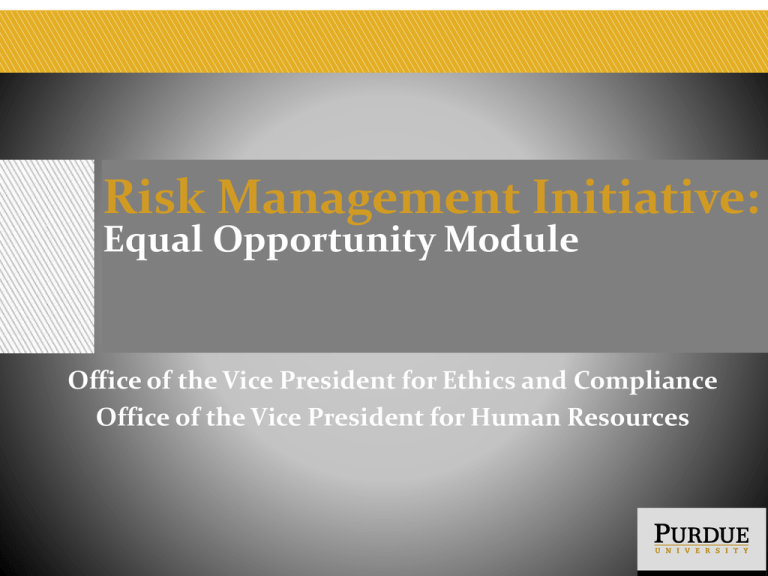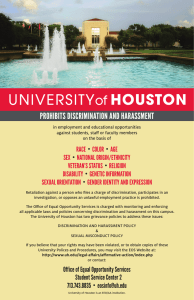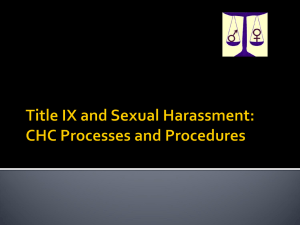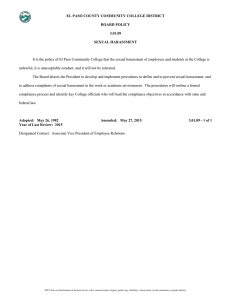
Risk Management Initiative:
Equal Opportunity Module
Office of the Vice President for Ethics and Compliance
Office of the Vice President for Human Resources
Learning Goal and Objectives
GOAL: Ensure
all members of
the University
community are
treated with
respect and
dignity to
create an
environment
free from
discrimination
& harassment
• Identify classes of individuals covered by law
and policy
• Apply knowledge of Purdue’s policies on
nondiscrimination, equal opportunity, equal
access and anti-harassment to recognize and
eliminate behavior that constitutes
discrimination or harassment
• Report child sexual abuse appropriately
• Explain how an amorous relationship could
negatively impact the University
• Describe Purdue’s procedures for resolving
complaints of discrimination and harassment
Relevant Federal and State Laws
•
•
•
•
•
•
•
•
•
•
•
•
•
Age Discrimination in Employment Act of 1967
Americans with Disabilities Act of 1990, as amended
Executive Order 11246, as amended
Equal Pay Act of 1963
Genetic Information Nondiscrimination Act of 2008
Immigration Reform and Control Act of 1986
Indiana Civil Rights Act of 1971
Pregnancy Discrimination Act
Sections 503 and 504 of the Rehabilitation Act of 1973
Title VI of the Civil Rights Act of 1964, as amended
Title VII of the Civil Rights Act of 1964, as amended
Title IX of the Education Amendments of 1972
Vietnam Era Veteran’s Readjustment Assistance Act of
1974, as amended
Nondiscrimination Policy Statement
Purdue University prohibits discrimination against any
member of the University community on the basis of:
•
•
•
•
•
•
•
•
•
Race
Color
National origin or ancestry
Sex
Religion
Age
Disability
Genetic information
Status as a veteran
•
•
•
•
Marital status
Parental status
Sexual orientation
Gender identity and
expression
Equal Opportunity
Evaluate and treat all persons on the basis of:
• Personal abilities
• Qualifications
• Other relevant characteristics
Anti-Harassment
• Committed to maintaining an environment that
is positive and free from all forms of harassment
• Harassment in all forms is unacceptable conduct
and will not be tolerated
Definition of Harassment
Conduct towards another person or identifiable
group of persons that has the purpose or effect of:
• creating an intimidating or hostile
environment; or
• unreasonably interfering with or affecting a
person’s educational environment, work
environment, or participation in a
University activity.
Examples of Harassment
•
Offensive or derogatory:
‒
‒
‒
‒
‒
‒
‒
‒
‒
‒
Objects
Cartoons
Posters
Screensavers
Comments
Slurs
Jokes
Stories
Emails
Gestures
•
•
•
Unwelcome touching
Leering
Blocking someone’s
movements
Stalking
Any knowing or intentional course of conduct involving
repeated or continued following, threatening or intimidating
another by telephone, mail, electronic communication, social
media, in person or any other action, device or method that:
• would cause a reasonable person to suffer substantial
emotional distress or fear of bodily injury or death
and
• actually causes such person substantial emotional
distress or fear of bodily injury or death
Racial Harassment
• Conduct that demonstrates hostility towards
another person or identifiable group of persons on
the basis of:
– Race
– Color
– National origin or ancestry
Sexual Harassment
1. Any act of sexual violence
– any non-consensual sexual act, including but not limited
to rape, sexual assault, sexual battery and sexual coercion.
Sexual violence also includes relationship violence.
2. Any act of sexual exploitation
– any act that exploits someone sexually
Sexual Harassment (continued)
3.
Any unwelcome sexual advance, request for sexual favors, or
other written, verbal, or physical conduct of a sexual nature in
certain contexts:
• Quid pro quo
‒ submission is made a term or condition of employment, education, or participation
in a University activity;
‒ submission to, or rejection of, is used as a factor in decisions affecting employment,
education, or participation in a University activity;
• Hostile environment
‒ such conduct creates an intimidating, offensive, or hostile environment; or
‒ such conduct unreasonably interferes with an individual’s employment or academic
performance or participation in a University activity.
Title IX
• Prohibits discrimination on the basis of sex in any
federally funded education program or activity
• Obligates the University to:
– Eliminate the harassment
– Prevent its recurrence
– Address its effects
Report Title IX Violations
Campus
Title IX Coordinators
West Lafayette Alysa Christmas Rollock
Vice President for Ethics and
Compliance
765-494-5830
titleIX@purdue.edu
Calumet
Linda B. Knox
Director, Office of Equity & Diversity
219-989-2337
linda.knox@purduecal.edu
Fort Wayne
Christine M. Marcuccilli
Director, Office of Institutional Equity
260-481-6106
marcuccc@ipfw.edu
North Central
Laura Odom
Assistant Director of OIE & Training
219-785-5545
odoml@pnc.edu
Reporting Child Sexual Abuse
• Indiana law requires all persons age 18+ to report suspected
child abuse or neglect to the police or child protective services
• May also report to Contact Person
– Responsible for reporting
– Does not relieve individual of obligation to report
• Failure to report is a Class B misdemeanor
• Reports may be made anonymously at
www.purdue.edu/hotline or 1-866-818-2620
Policy on Amorous Relationships
Definition:
• Romantic or sexual in nature
• Mutual and consensual
• Not married or in domestic partnership
Purdue prohibits amorous relationships between a:
• Student and any Purdue employee who has
educational responsibility over the student
• Supervisor and subordinate where there is a
supervisory or evaluative relationship
Amorous Relationships
• Disparity of power
– Consent by the student/subordinate becomes suspect
– Susceptible to exploitation and claims of sexual
harassment
• Effect on others
– Perceived favoritism
– Others think they have to do the same
– Hostile environment
• Must report to department or unit head
– Remove evaluative or supervisory relationship
• Violations subject to discipline
Resolving Complaints of Discrimination and Harassment
•
•
•
Applies to faculty, staff, students, participants and guests
Confidentiality
Right/Duty to act in absence of complaint
What is the Informal Resolution Process?
• Submit Complaint
Information Form
within 120 days
• Attempt
Resolution
Conclusion of Informal Resolution Process
The complainant
may decide to
stop further
action
The parties may
come to a
resolution:
• apology
• education
• reprimand
• other
intervention
Initiation of the
Formal
Resolution
Process
Formal Resolution Process
• Submit Complaint Information Form
within 120 days
• Investigation
• Determination by the Chancellor,
DOS, or Executive Director
• Chancellor, DOS, or Executive
Director and VP/Dean impose
sanctions
• Appeal
Sanctions
• Determined on case-by-case basis
•
•
•
•
•
•
Employee
Reprimand
Suspension or leave of
absence without pay
Reassignment
Demotion
Denial of merit pay
increase
Termination
•
•
•
•
Student
Warning
Probation
Probated Suspension
Expulsion
• Enhancement for bias motivated behavior or
administration of “rape drug”
Retaliation Prohibited
Individuals are protected against retaliation for:
• Reporting or complaining of discrimination or
harassment
• Assisting or participating in an investigation
• Enforcing university policies
Summary
Your responsibility:
• Know and comply with the University’s policies
and procedures
• Treat all members of the University with dignity
and respect to foster a community free from
discrimination and harassment
Conclusion
Risk Management Employment Claims Initiative
If you have any questions regarding this training please
contact vpeceducation@purdue.edu.
NOTE: In order to obtain credit for this training, you
must take the RMI Module 1 certification quiz in
WebCert.





